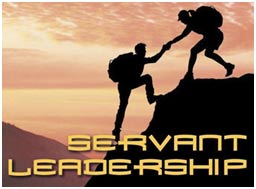
In prior Parts of this series, we defined the leadership model referred to as SERVANT LEADERSHIP as:
![]() “Servant Leadership seeks to involve others in decision making, is strongly based in ethical and caring behavior, and it enhances the personal growth of those around them while improving the caring and quality of organizational life.”
“Servant Leadership seeks to involve others in decision making, is strongly based in ethical and caring behavior, and it enhances the personal growth of those around them while improving the caring and quality of organizational life.”
We also described the first 5 attributes of a Servant Leader as being: 1) LISTENING; 2) EMPATHY; 3) HEALING; 4) AWARENESS &
5) PERSUASION
In this final part of the series, we’ll identify 5 more of the characteristics of a Servant Leader (SL for short).
6. Conceptualization:
- The traditional leader is consumed by the need to achieve short-term operational goals. The leader who wishes to also be an SL must stretch her/his thinking to encompass broader-based conceptual thinking.
- SLs are able to create a delicate balance between conceptual thinking and a day-to-day operational approach.
7. Foresight:
- Closely related to conceptualization is the ability to foresee obstacles, opportunities & outcomes. Foresight enables the SL to grow from the past, grasp the realities of the present, and gravitate to the future, which involves advanced intellect, keen insight & sound intuition.
8. Stewardship:
- Stewardship is holding something in trust for another rather than owning that something.
- Servant Leadership stewardship entails a commitment to serving the needs of others, & emphasizes the use of openness and persuasion, rather than control.
Remarkable automatic excitement is observable with doubled heartbeat rate and increase in systolic and diastolic blood pressure. click that levitra uk
9. Commitment to the growth of people:
- SLs believe that people have an intrinsic value that goes far beyond their tangible contributions as workers. Therefore, SLs are deeply committed to the development & growth (both professionally & personally) of those with their organization.
- SLs recognize this is a vitally important role & responsibility.
10. Building community:
- The SL recognizes that as a result of the shift from small local communities to large, often global organizations much of the sense of community has been lost. Consequently, the SL seeks to identify approaches & methods for building community among those who work within her/his organization.
- Although varying means are used, the result is the same—individuals feel a connection with one another.
As was pointed out previously, this model has been adopted by many of America’s most successful companies, including 50% of the companies on Fortune’s list of “100 Best Companies to Work For”.
- Regardless of whether your organization is a giant-sized multi-national corporation or a small family business, the adoption of Servant Leadership as your leadership model has the potential to impact it in multiple positive ways.
For more information about Servant Leadership or other Organizational & People Development matters:
- Email Trinity at info@TrintyHR.net
- Visit our website at www.TrinityHR.net
- Call us at 856.905.1762
You have HR opportunities…Trinity has paths forward!